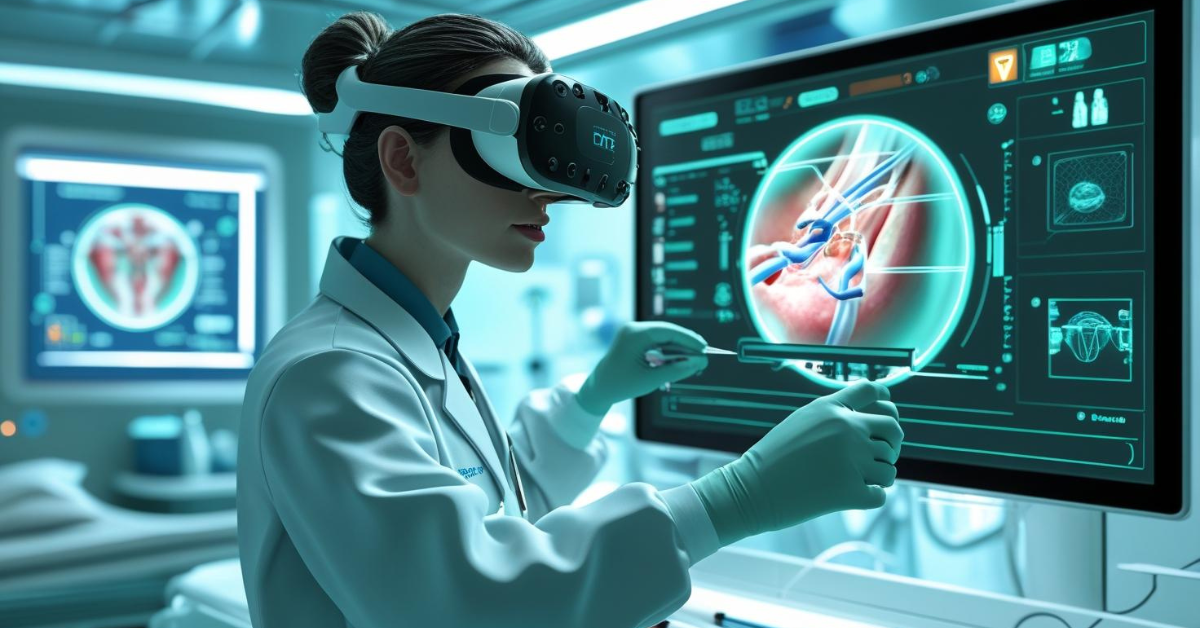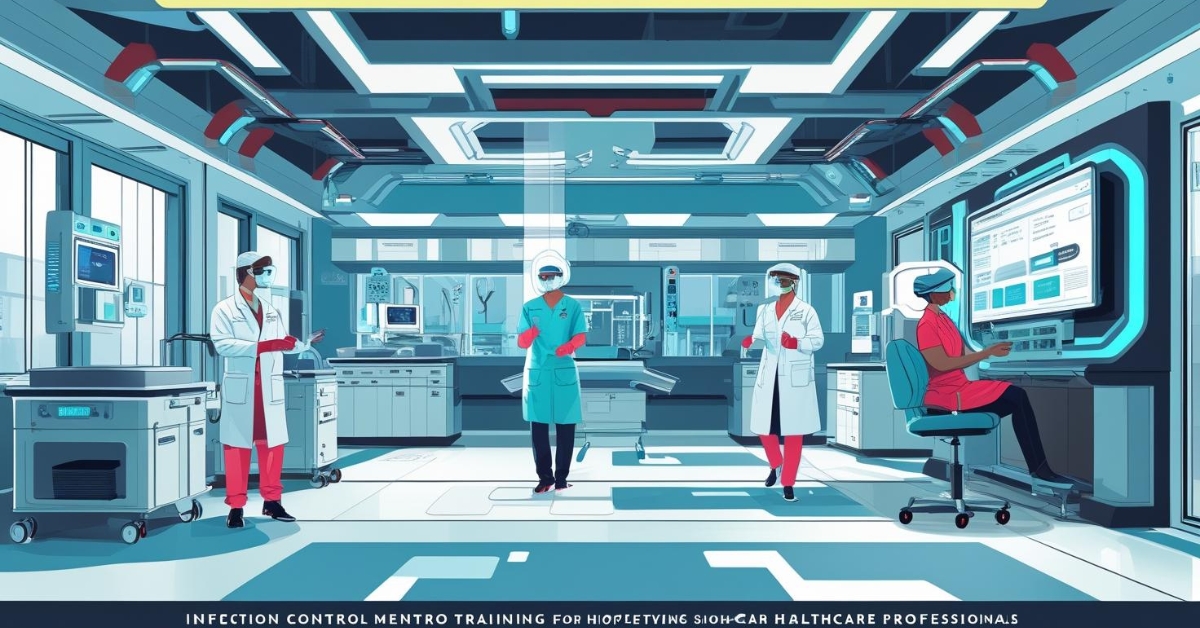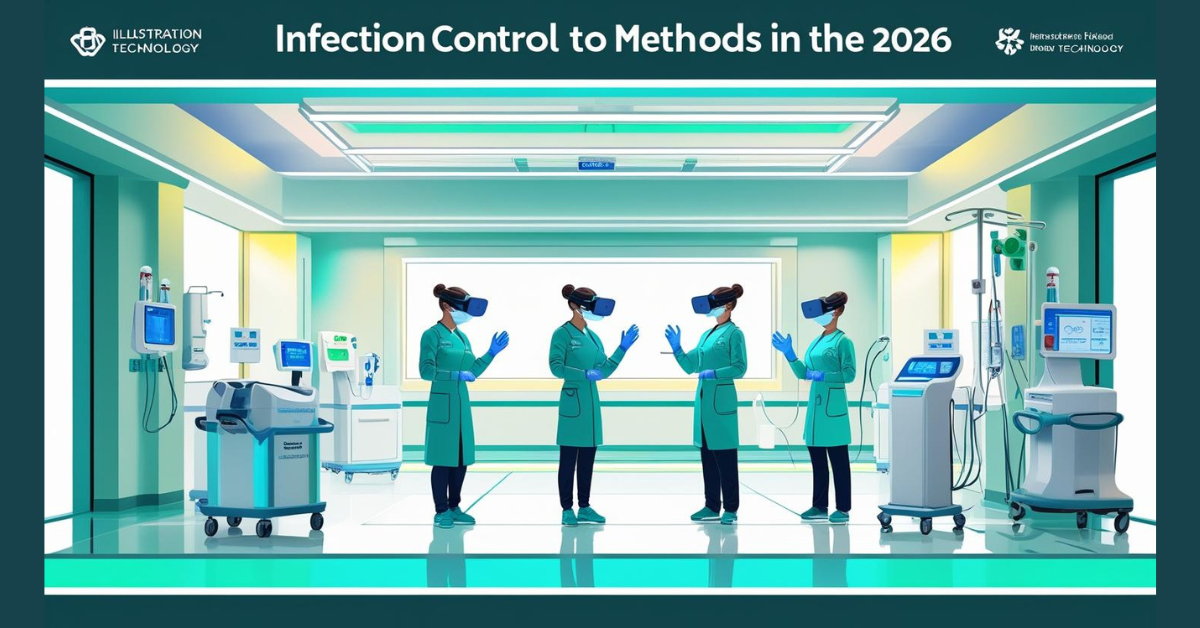The Infection Control with New Methods Like VR in 2026. This trend enables more dynamic and personalized VR experiences, where virtual worlds can evolve based on user behavior.
What Is Infection Control with New Methods Like VR in 2026
By 2026, infection control will increasingly utilize virtual reality (VR), among other advanced technologies. VR is used to train healthcare professionals in infection prevention and control (IPC) procedures, providing immersive and interactive experiences that improve knowledge, attitudes, and practices. This includes visualizing the spread of infections such as MRSA and performing hand hygiene in simulated environments.
Recent advances in intellectual property (IP) technologies include electronic hand hygiene monitoring systems, antimicrobial textiles, ultraviolet-C (UVC) devices, and the optimization of electronic health records (EHRs) with decision support and predictive analytics using machine learning for preventive healthcare. AI is being used to generate procedural environments, create intelligent non-player characters, and even manage entire worlds autonomously.
Executive Summary
The manner we manipulate infections has modified loads due to new technology like Virtual Reality (VR), Artificial Intelligence (AI), UV-C disinfection structures, and antimicrobial surfaces. As healthcare structures cope with greater complex infectious diseases, those new techniques are converting how we teach staff, easy environments, and screen fitness conditions in 2026.
Virtual Reality in Infection Control Training
The future of infection control in hospitals could involve greater integration of environmental surveillance, antimicrobial stewardship, and patient engagement, while promoting collaboration across healthcare facilities.
VR Applications for Healthcare Workers
Virtual reality has become a strong tool for teaching and training about infection control. New research shows that using VR can help healthcare workers follow infection control steps better.
Important uses of VR in training include:
- Teaching proper hand washing methods and when to wash hands through realistic experiences
- Practicing how to put on and take off protective gear safely
- Learning how to clean medical tools and surfaces correctly
- Simulating different types of infection control measures like contact, droplet, and airborne precautions
Advantages of VR Training
- Safe Learning Environment: Allows exercise without threat of real contamination
- Realistic Scenarios: Provides practical scientific settings for immersive learning
- Immediate Feedback: Real-time evaluation and correction of techniques
- Standardized Training: Consistent instructional revel in throughout all learners
- Cost-Effective: Reduces want for bodily materials and repeated demonstrations
Recent VR Developments in 2026
Mass General Brigham researchers have advanced modern VR equipment in particular designed to teach clinicians on middle contamination manage concepts, such as cleansing and disinfecting transportable clinical equipment. These structures recognition on stopping the unfold of infections in the course of healthcare centers via immersive, experiential getting to know.
VR Training Effectiveness
Research shows that VR getting to know appreciably improves implementation of contamination manage methods such as hand hygiene, right apron-carrying, and glove-carrying techniques. The era has confirmed specially powerful for schooling nurses in dealing with extensive care sufferers in the course of pandemic scenarios.
Artificial Intelligence in Infection Control
Artificial intelligence (AI) is transforming infection control by improving pathogen detection, outbreak prediction, optimizing antibiotic use, and improving hygiene practices. AI-based tools enable faster and more accurate diagnoses, proactive monitoring, and personalized treatment strategies, ultimately resulting in better patient outcomes and lower healthcare costs.
AI-Enhanced Surveillance Systems
Artificial Intelligence is reworking contamination manage surveillance through imparting computerized tracking and early detection abilities that surpass conventional guide methods.
AI Applications in Infection Prevention
- Predictive Analytics: Identifying patients at immoderate risk for healthcare-associated infections
- Real-Time Monitoring: Continuous surveillance of hand hygiene compliance
- Outbreak Detection: Early identification of infection clusters and transmission patterns
- Antibiotic Stewardship: Optimizing antimicrobial prescribing patterns
- Contact Tracing: Automated tracking of affected character and staff interactions
AI-Powered Disinfection Technologies
Revolutionary AI-more advantageous UV-C disinfection structures are redefining the contamination manage landscape. These clever structures optimize disinfection protocols primarily based totally on real-time environmental facts and pathogen threat evaluation.
Smart Disinfection Features
- Adaptive Protocols: AI algorithms modify UV-C publicity primarily based totally on room characteristics
- Pathogen Recognition: Targeted disinfection for unique microorganisms
- Automated Scheduling: Integration with medical institution workflow structures
- Performance Monitoring: Constant evaluation of disinfection effectiveness
Modern UV-C Disinfection Invention
Modern UV-C disinfection technology uses ultraviolet radiation in the C band (200–280 nm) to effectively neutralize or inactivate microorganisms such as bacteria, viruses, and fungi. This technology has evolved from its early applications in water and air purification to a wide range of modern applications, including healthcare, surface sterilization, and even integration into everyday devices. Its effectiveness, cost-effectiveness, and environmental friendliness make it a valuable tool in the fight against pathogens and improving public health.
Automated UV-C Disinfection Systems
UV-C generation has superior considerably with the creation of self-sufficient disinfection robots and specialized system disinfection devices.
Key UV-C Innovations in 2026
- Chemical-Free Disinfection: Eliminates want for harsh chemical disinfectants
- Rapid Cycle Times: Significantly quicker than conventional cleansing methods
- Portable Device Disinfection: Specialized structures for ultrasound probes and clinical system
- Room-Scale Disinfection: Autonomous robots for complete environmental decontamination
FDA-Cleared UV-C Technologies
Recent FDA clearances have confirmed new UV-C disinfection gadgets particularly designed for scientific equipment, which includes ultrasound probes. These structures provide healthcare experts fast, automated, and chemical-unfastened disinfection solutions.
Benefits of UV-C Disinfection
- Broad Spectrum Efficacy: Effective in opposition to bacteria, viruses, and fungi
- No Chemical Residues: Safe for touchy scientific equipment
- Rapid Processing: Significantly decreased turnaround times
- Automated Operation: Minimal body of workers intervention required
- Consistent Results: Standardized disinfection throughout all cycles
Antimicrobial Surface Technologies
Antimicrobial surface technologies are methods and materials that inhibit or eliminate microorganisms present on surfaces, thereby preventing their growth and spread. These technologies are crucial for infection control and are used in diverse sectors, including healthcare, manufacturing, and public spaces.
Smart Antimicrobial Coatings
Advanced antimicrobial surfaces are being incorporated into healthcare environments to offer non-stop contamination manage protection.
Types of Antimicrobial Surfaces
- Photo catalytic Titanium Dioxide: Self-cleansing surfaces activated with the aid of using light
- Copper Alloy Surfaces: Continuously energetic antimicrobial properties
- Silver-Infused Materials: Long-lasting antimicrobial protection
- Quaternary Ammonium Coatings: Broad-spectrum antimicrobial activity
Environmental Surface Applications
Antimicrobial technology is being carried out on diverse surfaces at some stage in healthcare facilities, including:
- High-Touch Surfaces: Door handles, mattress rails, and clinical equipment
- Medical Implants: Reducing chance of device-related infections
- HVAC Systems: Air purification and floor decontamination
- Textiles and Fabrics: Antimicrobial clinic linens and uniforms
Integration of Multiple Technologies
Comprehensive Infection Control Systems
Healthcare centers in 2026 are imposing incorporated contamination manipulate structures that integrate more than one technology for max effectiveness.
Multi-Modal Approach Benefits
- Layered Protection: Multiple limitations towards contamination transmission
- Real-Time Monitoring: Continuous evaluation of contamination manipulate measures
- Adaptive Responses: Dynamic adjustment primarily based totally on contemporary danger levels
- Data-Driven Decisions: Evidence-primarily based totally optimization of protocols
Smart Hospital Integration
Modern clever hospitals are incorporating that technology into complete contamination manipulate ecosystems that include:
- Automated Environmental Monitoring: Continuous air best and floor infection evaluation
- Staff Compliance Tracking: Real-time tracking of hand hygiene and PPE usage
- Patient Risk Stratification: AI-powered evaluation of contamination susceptibility
- Predictive Maintenance: Automated scheduling of cleansing and disinfection cycles
Discharge Challenges and Solutions
Technology Adoption Hurdles
- Cost Considerations: Initial funding in superior technologies
- Staff Training Requirements: Education on new structures and protocols
- Integration Complexity: Coordination with present clinic structures
- Regulatory Compliance: Ensuring adherence to contamination manipulate standards
Best Practice Implementation Strategies
- Phased Rollout: Gradual implementation throughout one-of-a-kind departments
- Comprehensive Training: Multi-modal schooling consisting of VR simulations
- Performance Monitoring: Continuous evaluation of era effectiveness
- Staff Engagement: Involving healthcare employees in era choice and optimization
Global Initiatives and Standards
International Collaboration
The 2026 International Congress of the Asia Pacific Society of Infection Control (APSIC) is centered on the theme “Innovation, Collaboration and Resilience in IPC: Adapting to a Rapidly Evolving World.” It shows the worldwide effort to improve infection control technologies.
Regulatory Framework Development
Healthcare structures international are growing new requirements and recommendations for:
- VR Training Certification: Standardized competency assessments
- AI System Validation: Evidence necessities for AI-powered contamination manipulate tools
- UV-C Safety Protocols: Guidelines for secure operation of disinfection structures
- Antimicrobial Surface Standards: Performance and protection necessities
Future Directions and Emerging Technologies
Next-Generation Revolution
- Augmented Reality (AR): Enhanced real-time steering for contamination manipulate procedures
- Internet of Things (IoT): Connected gadgets for complete environmental tracking
- Blockchain Technology: Secure monitoring of contamination manipulate compliance and outcomes
- Nanotechnology: Advanced antimicrobial substances and surfaces
Research and Development Priorities
- Personalized Infection Control: Tailored protocols primarily based totally on man or woman chance factors
- Genomic Surveillance: Real-time pathogen identity and resistance tracking
- Wearable Technology: Continuous tracking of publicity dangers and compliance
- Robotic Systems: Fully computerized contamination manipulate and environmental management
Cost-Effectiveness Analysis
Economic Effects of Advanced Technologies
- Reduced Healthcare-Associated Infections: Significant rate economic financial savings from prevention
- Improved Staff Efficiency: Automation reduces time spent on routine tasks
- Enhanced Patient Outcomes: Better infection manage consequences in stepped forward recovery rates
- Regulatory Compliance: Reduced threat of citations and penalties
Return on Investment Considerations
Implementation of superior contamination manipulates technology commonly indicates wonderful returns through:
- Decreased Infection Rates: Direct price financial savings from decreased remedy expenses
- Reduced Liability: Lower danger of contamination-associated felony issues
- Improved Reputation: Enhanced affected person and group of workers satisfaction
- Operational Efficiency: Streamlined workflows and decreased guide processes
Conclusion
The integration of Virtual Reality, Artificial Intelligence, UV-C disinfection, and antimicrobial surfaces represents a paradigm shift in contamination manipulate practices. These technology provide exceptional possibilities to enhance education effectiveness, decorate environmental decontamination, and offer real-time surveillance talents.
Success in enforcing those superior contamination manipulate techniques calls for a complete method that consists of generation selection, body of workers education, overall performance monitoring, and non-stop improvement. Healthcare corporations that embody those improvements even as preserving attention on essential contamination manipulate concepts can be great located to defend patients, body of workers, and groups from infectious sickness threats.
As we increase via 2026, the continuing evolution of those technology guarantees even more talents for contamination prevention and manipulate. The key to fulfillment lies in considerate implementation, ongoing evaluation, and dedication to evidence-primarily based totally practices that prioritize affected person protection and excellent care.
Related Post
https://nurseseducator.com/infection-control-best-practices-for-post-covid-in-2026/
Read More:
https://nurseseducator.com/didactic-and-dialectic-teaching-rationale-for-team-based-learning/
https://nurseseducator.com/high-fidelity-simulation-use-in-nursing-education/
First NCLEX Exam Center In Pakistan From Lahore (Mall of Lahore) to the Global Nursing
Categories of Journals: W, X, Y and Z Category Journal In Nursing Education
AI in Healthcare Content Creation: A Double-Edged Sword and Scary
Social Links:
https://www.facebook.com/nurseseducator/
https://www.instagram.com/nurseseducator/
https://www.pinterest.com/NursesEducator/
https://www.linkedin.com/in/nurseseducator/
https://www.researchgate.net/profile/Afza-Lal-Din
https://scholar.google.com/citations?hl=en&user=F0XY9vQAAAAJ



I do agree with all the ideas you have introduced on your post They are very convincing and will definitely work Still the posts are very short for newbies May just you please prolong them a little from subsequent time Thank you for the post